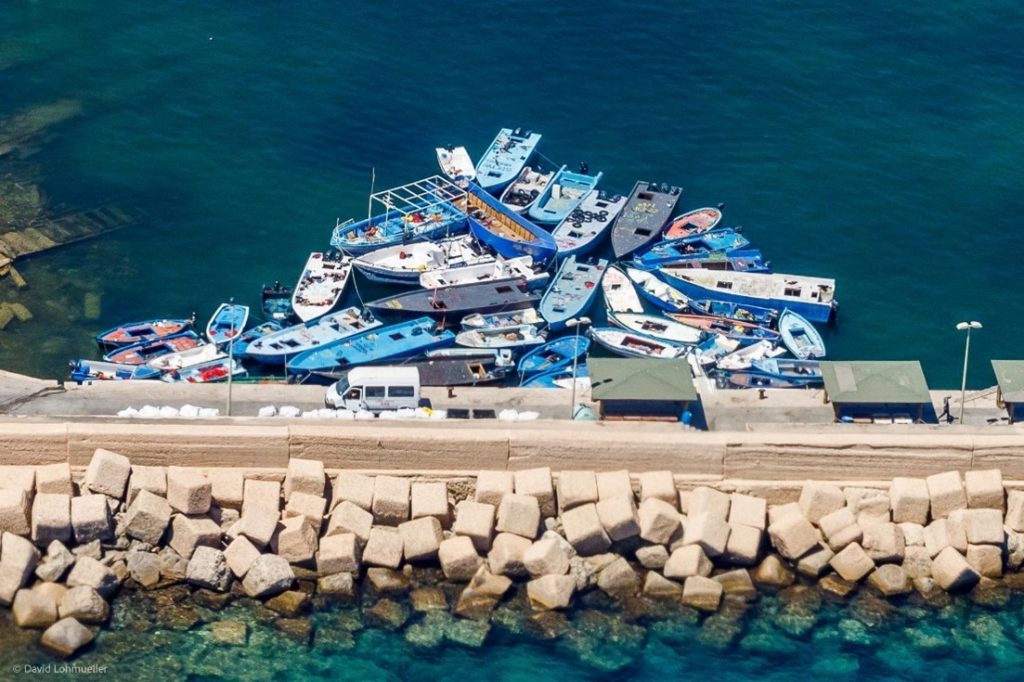 Empty boats in the port of Lampedusa. Source: David Lohmueller
Empty boats in the port of Lampedusa. Source: David Lohmueller
Introduction
Over the first six months of 2022, from the 1st of January until the 30th of June, Alarm Phone was alerted to 216 boats in distress in the central Mediterranean region, 112 of which reached Europe. In view of EU authorities regularly failing to rescue people in distress at sea, the collaboration between Alarm Phone and the civil rescue NGOs has proven crucial over recent months, leading to 59 successful rescue operations.
As expected, the spring-summer period with improved weather conditions is also the period of increased crossings, particularly from Libya and Tunisia. Based on information received from various sources, we are aware of about 500 boats in total that have left north African shores from Libya and Tunisia, seeking to reach the European Union. According to UNHCR statistics, 27,633 people arrived in Italy until the end of June. This is the highest number of arrivals in the first half of the year since 2017. Importantly, thousands of people have reached Italy autonomously, landing their boats on the shores of Lampedusa or being ‘greeted’ by Italian authorities shortly before arriving.
Over the past six months, about 10,000 people were intercepted at sea and returned to Libya, while about 9,300 people were returned to Tunisia. As we have documented time and again, these mass returns resulted from close collaborations between EU and north African actors, not least with Frontex drones and aircraft directing Libyan militias to escaping boats. With EU authorities investing in deterrence and containment, while abandoning people in distress at sea, the central Mediterranean Sea remains deadly. About 800 people were documented by IOM as having lost their lives or gone missing in this time period, but we know that the real figure is considerably higher.
In this analysis, we reflect on developments that occurred over the first six months of 2022:
First, we offer a detailed chronology of events in the central Mediterranean Sea. Documenting these developments is important: no other actor compiles such detailed account – we have to create our own archive of migrant struggles and acts of solidarity, as well as forms of border violence at sea
Second, we reflect on boat departures from the very east of Libya, places such as Tobruk or Benghazi. This migration route is not only very long, about 500 kilometres, but also very dangerous, not least due to the absence of civil rescue assets in that region of the sea.
Third, we examine Malta’s actions and inactions at sea, leading to only 35 people reaching the island nation over the past six months. Alarm Phone has witnessed this non-assistance policy in action innumerable times, abandoning boats at risk of capsizing within the Maltese Search and Rescue (SAR) zone.
Fourth, we highlight the situation within Libya, the mass arrests and detention campaigns there that have also sought to undermine self-organised refugee activism by imprisoning the courageous protestors in inhumane camps.
The developments in the central Mediterranean Sea over the past six month show once more that people are not deterred by Europe’s cruel migration policies and border control. They continue to move, now again in rising numbers, even if risking their lives time and time again. We will continue to support them along the way, and continue to fight the EU border regime.
CM-Chronology January -July 2022
January
In January, Alarm Phone was alerted to 23 boats in distress in the Central Mediterranean, most of them departing from Libya, four from Tunisia. Via several sources, we know of 64 boats in total, which left from these two countries. Five of the boats that alerted Alarm Phone were forced back to Libya, two to Tunisia. We know of at least six further interceptions. Seven of the 23 boats were rescued by NGO vessels (Geo Barents, Mare Jonio, Louise Michel and Aita Mari). One of these boats was rescued by the Italian Coastguard. NGOs also rescued four further boats. Four of the boats we were in contact with made it autonomously to Lampedusa and we know of 17 other boats which arrived on that island, most of them from Tunisia. One case with contact to Alarm Phone ended in a shipwreck and we know about three other shipwrecks, leading to at least 30 deaths and 31 people going missing.
On 3 January, UNHCR Libya closed its Community Day Center (CDC) in Tripoli where thousands of refugees had been staying and protesting for over three months, in search of protection and evacuations from Libya. Also at UNHCR’s main office, hundreds carried out protests and built a makeshift camp. Militias arrived and threatened the protestors.
On 4 January, Louise Michel rescued 31 people from a drifting boat. Another 65-70 people were holding out all night on the Shell oil platform Miskar. A Tunisian warship arrived on site and all people were pushed back to Tunisia.
On 10 January, military and police forces were deployed at the CDC and the UNHCR’s main office. People were beaten and arrested, tents were burnt to ashes. The peaceful sit-in of thousands of refugees was forcibly evicted and more than 600 people were taken to the detention center of Ain Zara in Tripoli.
On 12 January, the Department for Combating Illegal Immigration (DCIM), led by a notorious human trafficker listed by UN Sanctions Committee, announced that they were looking for two refugees identified as “leaders” of the protest. They feared to be killed once arrested.
On 19 January, Louise Michel alerted by Alarm Phone to a boat in distress, witnessed how the so-called Libyan Coastguard intercepted the boat and shot at a person who had jumped into the water.
On the same day, Mare Jonio rescued a dangerously overcrowded boat off Libya that had alerted Alarm Phone. Geo Barents found and rescued another large boat in distress.
On 20 January, Mare Jonio rescued two other boats in distress that had reached out to Alarm Phone.
On 22 January, we learned about a boat that had capsized off Tunisia. Eleven people died, 21 people were rescued. On the same day, Geo Barents was searching for a boat that had alerted Alarm Phone. The people had arrived at the Miskar oil platform in the Maltese Search and Rescue (SAR) zone and were intercepted and pushed back by the Tunisian navy.
On 25 January, seven migrants died on board a boat which had called Alarm Phone. 280 people were finally rescued by the Italian Coastguard.
On 27 January, 36 people were feared dead after their boat had capsized off the Tunisian coast. They had left Libya on a boat with a total of 70 people.
February
In February, we were alerted by 26 boats in distress, among them one departing from Tunisia, the others from Libya. From diverse sources, we know about 46 boats in total which left from Libya. Eight of the 26 boats were intercepted by the so-called Libyan Coastguard, one by the Tunisian Coastguard. Three of the 13 other interceptions we learned about were conducted by the Libyan SSA (Stability Support Apparatus – see article below). NGO vessels (Ocean Viking and Sea Watch 4) rescued five of the boats which alerted us and two further boats in distress. Six or seven of the 26 boats arrived in Lampedusa – at least ten further boats reached the Italian island. We learned about seven shipwrecks, none of them Alarm Phone cases, which lead to at least 35 deaths and 35 other people going missing.
On 1 February, the EU Commission announced the delivery of three new SAR vessels and two patrol boats to Libya. On the same day, massive protest rose inside Ain Zara detention center against the visit of criminal officials and the ill-treatment of the incarcerated. Some days before, expulsions of about 1000 migrants from southern Libya to the border of Niger were reported.
On 5 and 6 February, CommemorActions took place in Tunisia, Malta and many other places to remember the dead and the missing at borders. Refugees inside Ain Zara detention center went on hunger strike for the second day.
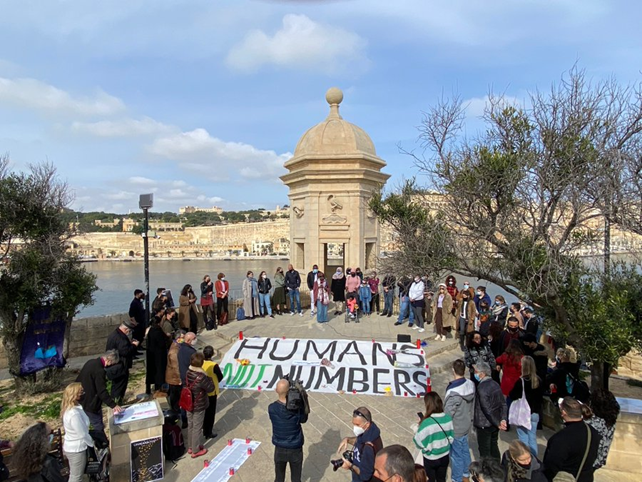 CommemorAction on 6 February in Malta, Gjardola Garden, Source: Alarm Phone
CommemorAction on 6 February in Malta, Gjardola Garden, Source: Alarm Phone
On 11 February, it was announced that with a new cooperation agreement, the EU military mission EUNAFVOR MED would offer its “Automated Behaviour Monitoring” (ABM) capabilities to “keep a close eye on Libya’s ports” and target vessels based on “suspicious behaviour”.
On 12/13 February, Alarm Phone was alerted by 12 boats in total. Four of them were probably intercepted, two were rescued by the Ocean Viking, six arrived in Lampedusa. On 13 February, 111 migrants were intercepted by the SSA and transferred to the SSA detention center in Al Maya
On 14 February, AFM told a merchant vessel not to rescue migrants in distress in Malta’s SAR zone.
On 15 February, migrants protests in Tunisia were reported, calling for evacuation. Alarm Phone and other organisations published a solidarity statement. In Libya, UNHCR released 64 vulnerable refugees from Ain Zara detention center, but for Refugees in Libya, the self-organised refugee protestors in Libya, this is no solution in a country which is not safe.
On 15 and 16 February, two arrivals of about 80 and 98 migrants on sailing boats in Calabria were reported.
On 19 February, Sea Watch 4 rescued 121 people who had alerted Alarm Phone. In another case, the NGO vessel tried in vain to prevent another interception by the SSA.
In the period of 13-19 February, 632 migrants were intercepted and returned to Libya.
On 20 February, at least two more interceptions took place, one of them again by the SSA. Even IOM denounced their “excessive use of force” that resulted in the killing of one migrant in another case.
On 22 February, about 200 people who had alerted Alarm Phone and even more people from another big boat were rescued by four Coastguard vessels at the Ionian coast and brought to Augusta/Sicily. In total, 573 migrants were rescued by the Italian Coastguard.
On 26 February, Geo Barents was trying to rescue people on a boat in distress off Abu Kammash, but SSA intercepted them.
On 28 February, we learned that at least nine migrants drowned in a shipwreck off Tunisia.
March
In March, Alarm Phone received distress calls from 19 boats. Most of them left from Libya, one boat moved from Turkey toward the Calabrian coast. In total, we know, from different sources, about the departure of 41 boats, 14 of them from Tunisia, the others from Libya. Seven of the boats that alerted us were forced back to Libya, two of them by the SSA. We were informed about six more interceptions to Libya. NGO vessels (Geo Barents, Ocean Viking and Sea Eye 4) rescued five of the 19 boats in contact with Alarm Phone and two other boats. There was one transshipment from a merchant vessel, which rescued 32 people, to Sea Eye 4. One of the boats we were in contact with arrived in Lampedusa, also at least ten other boats, all from Tunisia. Three boats which alerted us shipwrecked, two of them had left from Tunisia, one from Khoms/Libya. We also know about a shipwreck off Tobruk in east Libya. In total, 65 people were reported dead, 35 missing.
On 1 March, the first (and until now only) humanitarian evacuation flight of the year from Libya to Italy took place. Almost 100 vulnerable asylum seekers were brought to safety.
On 5 March, Seabird witnessed an illegal pullback of a boat with about 200 people to Libya. According to our information, a Frontex drone apparently guided the so-called Libyan Coastguard to the boat.
On the same day, Geo Barents rescued a boat in distress, carrying 80 people escaping from Libya who had alerted Alarm Phone.
On 5 and 6 March, a boat carrying about 26 people, who had alerted us, was at risk of capsizing off Libya. We asked European Coastguards to coordinate a rescue operation. Merchant vessels were close by. The CMA CGM Rivoli rescued the people. But Malta and Italy denied coordination and disembarkation. Eventually, the 26 people were brought to France.
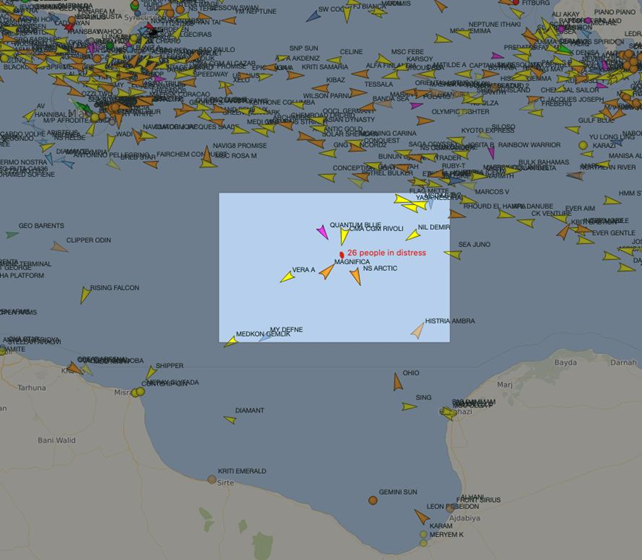 6 March 2022 – Vessels in the vicinity of the 26 people in distress in international waters. Source: vesselfinder.com
6 March 2022 – Vessels in the vicinity of the 26 people in distress in international waters. Source: vesselfinder.com
On 6 March, the SSA intercepted a boat that had alerted us the day before and brought the people to a detention center in Libya.
On the same day, after 6 hours of searching in the darkness and bad weather conditions, Geo Barents rescued 31 people who had called Alarm Phone in severe distress.
On 8 March, a total of 185 migrants landed in Roccella Ionica, Calabria. Two Italian patrol boats transferred them from a fishing boat in distress.
On 9 March, the opening of an new detention center at Tripoli airport was announced.
On 13 March, a shipwreck off the Libyan coast near Tobruk was reported. At least 18 of the 23 people on board drowned.
On 18 March we learned that also two boats had shipwrecked off Tunisia.
On 19 March, raids took place in Zuwara. Over 400 migrants were arrested.
On 25 March, we learned that a boat from Sfax, that had alerted us, capsized. Only three survivors were found, six bodies were recovered, the others are missing.
On the same day, the Ocean Viking rescued 128 people who had alerted Alarm Phone. Sadly, two people were found dead and due to extreme weather conditions, only one of the bodies could be recovered.
On 26 March, three years after the ElHiblu3 were arrested and who continue to face preliminary charges of terrorism, a Freedom Conference was organised in Malta.
On 27 March, Alarm Phone was called by 32 people on a drifting boat in stormy weather off Benghazi. State actors ignored the distress situation, but the merchant vessel Karina, which we had contacted, rescued the people. Sea Eye 4 offered transshipment, although they were quite far away. 50 hours after the rescue, the 32 people were transferred to the adequately equipped Sea Eye 4. Fortunately, they were soon assigned a port to disembark.
On 30 March, 119 asylum seekers were evacuated from Libya to Rwanda. We doubt that their hopes to be in safety now will become reality.
On 31 March, 145 people who alerted Alarm Phone were forced back to Libya. Another boat that we called us was rescued by the Sea Eye 4.
April
In April, we were alerted by 23 boats, most of them coming from Libya, one from the Ionian Sea, which in the end was rescued to Greece. Five of these boats were intercepted by the so-called Libyan Coastguard, one of them in the Maltese SAR zone. One of the boats was forced back to Tunisia. We know, from diverse sources, of at least ten more interceptions, one of them by the SSA and one by the Coastguard of Tobruk, east Libya. NGO vessels (Sea Watch 3, Geo Barents and Ocean Viking) rescued six of the boats that had alerted us and two further boats. Five of the 23 boats in contact with us arrived in Lampedusa as did at least 20 other boats, which had not reached out to us, mostly from Tunisia. Two of our cases shipwrecked. Both boats had departed from Libya. We know of three more shipwrecks, one off Libya, three off Tunisia as well as one boat which had left from Lebanon. In total, these shipwrecks led to at least 64 deaths and 79 people going missing.
On 1 April, we learned that a boat that had alerted Alarm Phone the day before, was intercepted by the so-called Libyan Coastguard after several hours in severe distress. 126 people were taken to Libya and detained. Four children and seven women were found dead.
On 2 April, a boat carrying more than 100 people capsized in international waters near Libya. Four survivors were rescued by the merchant vessel Allegria 1, but then illegally forced back to Libya after ignoring MSF’s offer of medical assistance.
On 3 April, the ElHiblu 3 met Pope Francis to tell him about their never-ending trial in Malta. The Pope accused states of complicity in violations of migrants’ rights.
On 4 April, UNHCR reported the resettlement of only 15 refugees from Libya to Europe.
On 9 April, eight boats, carrying about 460 people, landed in Lampedusa.
On 9 and 10 April, the Sea Watch 3 performed five rescues, one of them was a boat that had alerted Alarm Phone and capsized, over 50 people were found in the water.
In the period of 3-9 April, 497 migrants were intercepted and returned to Libya.
From 8 to 11 April, four shipwrecks happened.
On 12 April, over 500 people arrived in Pozzallo/Sicily on a fishing boat.
On 13 April, an online event with Refugees in Libya took place, amplifying their voices.
On 14 April, 18 refugees were arrested in Tunis. The arrests took place after a group of 210 people had expressed their frustration with the lack of response from the UNHCR, and had moved their protest to the agency’s headquarters located in Tunis.
 Protest of refugees in front of UNHCR Office in Tunis. Source: a protester who would like to stay anonymous
Protest of refugees in front of UNHCR Office in Tunis. Source: a protester who would like to stay anonymous
On 15 April, the Libyan security forces carried out violent nightly raids on the homes of migrants in Zuwara. 300 people were arrested and most of them transferred to Ain Zara detention center.
On 16 April, a shipwreck off Sabratha was reported. The bodies of six people were retrieved, 29 others went missing and are presumed dead.
On 21 April, the EU Commission promised new patrol vessels to Libya.
On 23 April, the Geo Barents rescued 101 people from a boat that had alerted Alarm Phone. Also another shipwreck happened off Sfax. Media reported that four boats departed from Tunisia sank, 12 migrants died, 10 were missing.
On 24 April, 50 people were drifting just 30nm off Lampedusa in an overcrowded boat. Alarm Phone alerted authorities -many hours later, rescue by the Italian Coastguard was confirmed. On the same day, 89 people who had alerted us from the Ionian Sea, arrived in Calabria.
Also on 24 April, security forces in Libya arrested more than 600 migrants in Misrata and transferred them to the Tariqal Matar detention center in Tripoli.
On 25 April, the Ocean Viking performed another critical rescue of 94 people from a rubber boat in distress in international waters off Libya. During the operation, a Libyan patrol vessel arrived at the scene, causing anxiety among the distressed people. During their last rescue, 15 people of the overcrowded rubber boat fell into the water during the night. Only 3 made it back, the others likely drowned.
On 26 April, it was reported that Libyan authorities arrested and detained more than 540 people on the weekend before, mostly Bangladeshi nationals, who were said to be preparing to leave for Europe on inflatable boats.
On 28 April, the Civil Fleet rescue ships sounded their sirens in support of Lampedusa, the Island of Peace. On the same day, Refugees in Libya spoke directly to EU Parliament members during an online event at the European Commission.
On 29 April, Frontex director Leggeri resigned. On the same day, a man on board of the Geo Barents jumped into the sea. It was almost one week after he had been rescued together with 100 others and the ship was still waiting for a port of safety.
May
May was a very busy month for Alarm Phone and the Civil Fleet. We were alerted by 59 boats, 57 of them had departed from Libya, one from Tunisia and one from Turkey. Via other sources, we learned about 118 boats in total that had left from Libya. 12 of the boats we were in contact with were intercepted by the so-called Libyan Coastguard. We know of 26 more forced returns to Libya, two of them by the SSA, and of one to Tunisia. NGO vessels (Sea Watch, Sea Eye, Geo Barents, Ocean Viking, Astral, Nadir) rescued 14 of the boats which alerted us and two further boats in distress. In one case, a transshipment from a merchant vessel, which had rescued 34 people, to the Sea Eye 4 took place. One boat from Benghazi was rescued by the Italian Coastguard, another one was monitored by a merchant vessel and finally brought to Malta. A boat that had left from Tobruk was rescued to Greece. Eight boats that alerted us arrived in Lampedusa. In total, we heard about 32 boats from Libya and 35 boats from Tunisia that reached this island in May. One boat which was in contact with us shipwrecked and one person died, 75 went missing. In total, we learned about 35 deaths and 186 people going missing in this and two other shipwrecks.
On 3 May, units of the Western Region Support Forces in Libya arrested 86 migrants of different nationalities who wanted to escape Libya on boats. They were incarcerated in militia prisons.
On 5 May, the Turkish navy in coordination with the so-called Libyan Coastguard rescued 17 migrants from Bangladesh after their boat had capsized off Misrata.
On 6 May, Alarm Phone was contacted by 34 people in distress off Benghazi. We alerted authorities, but RCC Malta denied responsibility. Two days later, the people were rescued by a merchant vessel and on 9 May transshipped to the NGO vessel Sea Eye 4.
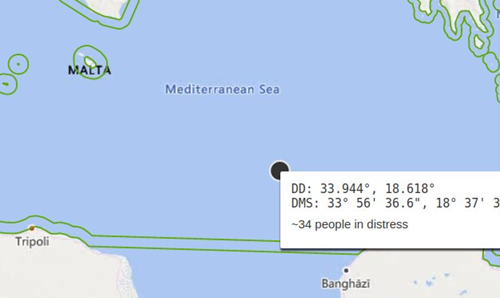 Map showing the position of the boat from Benghazi on 6 May. Source: Alarm Phone
Map showing the position of the boat from Benghazi on 6 May. Source: Alarm Phone
On 9 May, the Geo Barents found and rescued two overcrowded rubber boats of which one had called Alarm Phone.
On 10 May, after three more alerts from Alarm Phone and with areal support of Pilotes Volontaires, the Geo Barents rescued another 171 people from three boats.
On 11 May, Alarm Phone was again alerted by a boat off Benghazi. The communication with the people in distress was difficult, we lost contact and demanded an aerial search operation.
On 12 May, Alarm Phone was in contact with 24 people in distress in Maltese SAR. Authorities ignored our calls, a merchant vessel nearby was ordered to stay and keep on monitoring from distance. Finally, on 13 May, Sea Eye 4 was able to take the people on board.
On 14 May, Alarm Phone was called by 18 people fleeing Libya. They left Tobruk two days before and were in Maltese SAR. We received the confirmation that they were rescued by the Greek Coastguard and brought to the port of Kalamata.
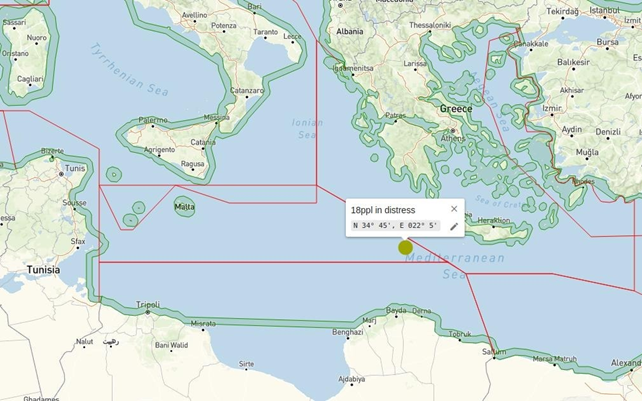 Map showing the position of the boat from Tobruk on 14 May. Source: Alarm Phone
Map showing the position of the boat from Tobruk on 14 May. Source: Alarm Phone
On 15 May, we were in contact with a boat in urgent distress off Benghazi. Later in Maltese SAR, a merchant vessel nearby was told by RCC Malta to continue their route and disregard the distress case. Only on 17 May, authorities told us that they were searching for these 26 people and after a large SAR mission with two Italian Coastguard assets were they rescued off the coast of Syracuse.
On 19 May, the crew of Ocean Viking rescued 158 people from two overloaded rubber boats in the Libyan SAR zone. Alarm Phone had been called by the travellers before.
On 22 May, Nadir found 75 people on a rubber boat after Alarm Phone had informed them. They could stabilize the boat until the Ocean Viking arrived and took the people on board.
On 24 May, the sailing vessel Astral of Open Arms followed an alert of Alarm Phone and rescued 110 people in distress.
On 25 May, the two sailing vessels Nadir and Astral rescued 110 people in a joint operation. Alarm Phone had informed them about the distress case. On the same day, 76 deaths were feared after a boat capsized off Sfax. Only 24 people could be rescued.
On 27 May, we learned that Father Zerai, who inspired the Alarm Phone project, is no longer being criminalised. After a 5-year-long investigation, the ridiculous charges of “aiding and abetting illegal migration” were dropped.
On 28 May, the merchant vessel Antigone rescued eight people who had fled eastern Libya and called the Alarm Phone.
On 29 May, the Libyan Coast Security Tobruk branch commenced with patrols at the eastern coast of Libya.
On 30 May, Nadir assisted a boat in distress that had alerted Alarm Phone until the new speed boat Aurora arrived and performed its first rescue operation, rescuing 86 people.
In May and the beginning of June, dozens of migrants were protesting in front of the UNHCR office building in Tunis. They were trying to draw the attention of the media and aid organizations to their living conditions, and to demand that UNHCR expedite their requests for protection and resettlement.
June
In June, Alarm Phone was alerted to 66 boats, 57 of them from Libya. In total, we heard of 167 boats which left Libya during this month. 13 of the boats we were in contact with were forced back to Libya. 22 of the 66 boats were rescued by NGO vessels (Sea Watch 3 and 4, Mare Jonio, Imara, Sea Eye 4, Aita Mari, Nadir, Louise Michel, Ocean Viking). One boat was rescued by a merchant vessel. We know for diverse sources of 34 boats from Libya and 77 boats from Tunisia which arrived autonomously to Lampedusa. At least four shipwrecks happened off Libya and more off Tunisia. We heard of 58 people who died and 25 going missing.
On 2 June, following an Alarm Phone alert, Sea Watch 3 rescued 49 persons in distress and later another boat with 25 people.
On 3 June, the Sea Watch 3 rescued 99 people who had called Alarm Phone and spotted another distress case of 49 people.
On 4 June, Alarm Phone alerted Italian authorities to a group in distress who departed from Lebanon. We learned that the 66 people on a sailing boat arrived in Roccella/Calabria. This was the 22nd landing of migrants at this coast in 2022.
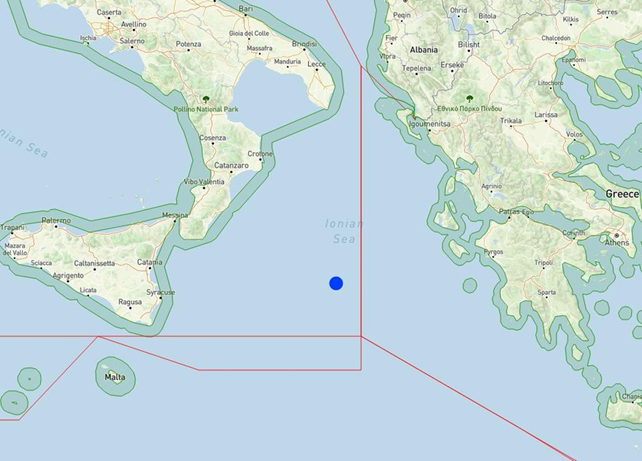 Map showing the position of the boat from Lebanon on 4 June. Source: Alarm Phone
Map showing the position of the boat from Lebanon on 4 June. Source: Alarm Phone
On 5 June, the NGO vessels Sea Watch 3 and Mare Jonio followed an Alarm Phone alert and managed to rescue 85 people. Mare Jonio rescued another boat in distress. The so-called Libyan Coastguard tried unsuccessfully to hinder the rescue operation.
On 6 June, the sailing vessel Imara found 63 people in distress, informed authorities and NGOs, and assisted the people until Mare Jonio arrived on scene and rescued them. The same day, the young Mohamed hanged himself to death in the Libyan detention center Ain Zara. Some days later, the survivors on the Mare Jonio published a statement, mourning this loss.
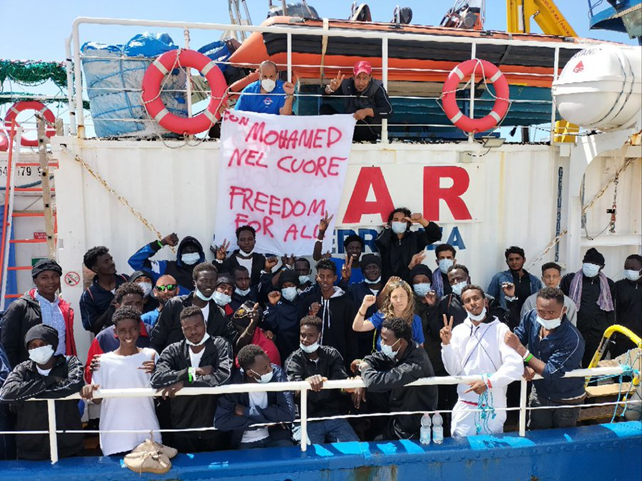 Solidarity action of refugees on Mare Jonio. Source: Mediterranea Saving Humans
Solidarity action of refugees on Mare Jonio. Source: Mediterranea Saving Humans
On 7 June, 25 people in distress who had alerted Alarm Phone were finally rescued by the Italian Coastguard after a long search by the Mare Jonio.
On 9 June, after several days waiting in front of the Italian coast, Sea Watch 3 and Mare Jonio were allowed to disembark in Pozzallo.
On 10 June, Refugees in Libya reported about a mass expulsion from Libya via trucks towards countries of origin.
On 13 June, Sea Eye 4 rescued 63 people who had called Alarm Phone for help after they had departed from Abu Kammash, western Libya.
On 14 June, Aita Mari rescued eleven people in distress who had reached out to Alarm Phone.
On 15 June, Sea Eye 4 rescued 416 people from three boats in distress. Aita Mari rescued 17 people who had jumped into the water, after a Libyan patrol boat had already forced 103 people to board their boat to return to Libya.
On 16 June, Aita Mari rescued 40 people and Sea Eye 4 rescued 76 people who had called Alarm Phone. In Lampedusa, 29 landings in 36 hours were reported. The same day, the trial against Iuventa crew and other actors was suspended due to grave procedural errors by the prosecution.
On 17 June, the fast boat Louise Michel found and rescued 17 people who were about to be intercepted back to Libya. A Frontex drone was on scene and probably involved in organizing the pushback.
On 18 June, Nadir found 29 people in distress, while Louise Michel rescued 52 people on a rubber boat who had called Alarm Phone. Sea Watch aircraft Seabird 1 spotted another boat in distress and was able to alert a nearby merchant vessel, which rescued the 95 people. All persons of the different rescues were transferred to Sea Watch 4.
On 19 June, Alarm Phone was alerted by a boat with 30 people who had left Benghazi and spent already two days at sea. A merchant vessel which we asked to intervene, passed by without rescuing.
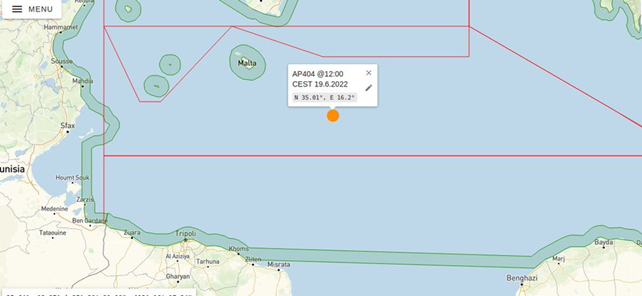 Map showing the position of the boat in distress which left from Benghazi. Source: Alarm Phone
Map showing the position of the boat in distress which left from Benghazi. Source: Alarm Phone
On 23 June, Nadir rescued 19 people in distress, who had called Alarm Phone. The same day, it was reported that Aurora was blocked by the British authorities from rescuing migrants in the Mediterranean.
On 24 June, Louise Michel rescued 59 people in distress, who were found by a passing fishing vessel which sent out a mayday requesting any assets in the vicinity to assist.
On 26 June, Ocean Viking rescued 75 people from an overcrowded rubber boat in distress in the Libyan SAR zone.
On 27 June, Geo Barents followed a distress alert of Alarm Phone. Once the vessel arrived on scene, the boat in distress had collapsed. About 30 persons of the 100 people originally on the boat went missing. Again, the Civil Fleet was the only actor responding. Another boat in the area was rescued by Ocean Viking.
On 30 June, more than 24 hours after Alarm Phone had alerted authorities, 36 people in distress were finally rescued to Sicily. The same day, the Ocean Viking conducted three rescue operations to boats alerted by Alarm Phone.
500 kilometres of non-assistance. The route from eastern Libya
For several months now, Alarm Phone is regularly receiving calls from the very east of Libya. Boats leave from places such as Tobruk or Benghazi. In addition to well-known big fishing vessels (for example the large landing in Calabria of 23 July with 674 people on board who departed from Tobruk), we have also noticed smaller boats on this route. Usually, 20-30 people are heading to Sicily or to Italian mainland – a distance of around 500 kilometres, which means that boats are for several days at sea, a period during which they can get into severe trouble.
The long journey from Libya to Italy crosses the Maltese Search and Rescue Zone. The so-called Libyan Coastguard is not too active in the eastern region to stop boats moving toward Europe. In September 2021, two Libyan Coastguard interceptions were reported where MRCC Rome was coordinating the interceptions inside the Libyan SAR zone with vessels belonging to the port authority of Benghazi. When boats reach the Maltese Search and Rescue area, the travelers have already spent many hours at sea and often report serious exhaustion, hunger and thirst. For the Armed Forces of Malta, these dangerous circumstances are insufficient reason to launch a rescue operation, despite their obligations to do so under international and maritime law. Moreover, assets of the civil fleet are often too far away or absent from the western maritime route from Libya to Italy, and thus cannot conduct rescue operations. Often, it comes down to merchant vessels to offer assistance. In several cases, as we now go on to show, Alarm Phone has been able to get merchant vessels involved.
On 5 March, the vessel Rivoli took 26 people onboard, who were eventually disembarked in Dunkerque in France on March 13. On 6 May, Alarm Phone was alerted to 34 people who had left from Benghazi. We tracked the merchant vessel Berlin Express close to the boat, which, sailing under the German flag, arrived on scene around midnight and started to monitor the situation. The vessel was unable to take the people on board, as the distressed could not climb a ten-meter-long ladder up. The weather was also too bad to launch a rescue boat. Italy and Malta knew about the case, but failed to render any assistance. The German RCC (Rescue coordination center) Bremen, as the responsible authority of the vessel’s flag state, was asked by the Berlin Express to assist the boat in distress and finally coordinated the intervention from afar. Although they informed RCC Malta several times, they never received a reaction. The Berlin Express provided drinking water and blankets to the people on the wooden boat, before it was let adrift and the winds pushed the boat back into the Libyan SAR zone. During the night, the BSG Bahamas, another merchant vessel, arrived on scene. In the end, four vessels were on scene: The Berlin Express, the Navigator Galaxy, the BSG Bahamas, and the Forest Park. On 8 May, around noon, the BSG Bahamas finally embarked the survivors and left the scene, heading west. Later on, the people were transshipped to Sea-Eye 4 and disembarked in Sicily.
In the early morning of June 29, our hotline was called by 36 people in distress who had fled Libya from Benghazi. Alarm Phone alerted the authorities, as the weather situation was deteriorating very fast, but no one came to rescue. We contacted several merchant vessels that were passing by, but none of them intervened. We alerted the vessel Allegra and later on the merchant vessels Lilac Promenade, Global Frontier, the oil tanker Lisa Essberger, as well as the tanker Al Aamriya but without success. The responsible RCC Malta failed once more to take the responsibility to order the merchant vessels to rescue the travelers on the tiny fiber boat. Alarm Phone contacted the Armed Forces of Malta several times, but the officers ignored multiple alerts. Also MRCC Rome failed to react adequately to our alert. We continued to receive distress call from the group which grew increasingly desperate over time. They were exhausted, and one man on the phone told us: “The children don’t move anymore as if they were dead and water is jumping into the boat.” When the group reached finally the Italian Search and Rescue zone, still there was no one there to support them at sea. Only in the afternoon of 30 June, did we finally receive the confirmation that an Italian Coastguard vessel had rescued the group. They were disembarked in Pozzallo, more than 24 hours after our first alert of authorities.
In the night of 24 May, 31 people alerted us. They had also departed from Benghazi, five persons were reported injured. As no state actor was reacting to our alerts, we searched once more for merchant vessels in the area. We alerted the vessel Sea Loyalty, sailing under Maltese flag, but it failed to intervene. The people on the phone started to panic due to the strong wind and high waves. In the meantime, RCC Malta asked for a picture of the boat, supposedly to decide if the boat was really in distress. As the boat was still able to move, RCC Malta didn’t consider the boat a distress case. In the morning, the oil tanker Histria Coal agreed to support the people in distress and to provide food, water and fuel to the group, but wouldn’t take the people onboard. The vessel monitored the situation for several hours, during which we lost contact to the people. In the morning of May 26, we learned that the group was disembarked in Malta.
Malta’s decreasing numbers of rescues at Sea
“The Armed Forces of Malta have never failed to do their duty when it comes to rescues or the coordination of rescues and they never will.” With these words, Byron Camilleri, Malta’s Home Affairs Minister defended Malta’s behavior concerning people in distress at sea in July 2022. Based on the experiences we have made over several years now, we know that these words are neither true nor sincere. Malta’s non-assistance policy can be witnessed weekly if not daily. We have experienced it uncountable times when we were stuck in the queue while trying to reach RCC Malta on the phone. We are not the only ones who have documented the irresponsible behaviour by the Armed Forces of Malta and RCC Malta. In May 2022, the European Council on Refugees and Exiles (ECRE: 11) published their 2021 country report about Malta in which they state: “Since May 2020 and throughout 2021, the Armed Forces of Malta (AFM) drastically decreased its rescues at sea.” In the first six months of 2021, Malta rescued merely 35 people.
We want to highlight just one of several examples of AFM’s non-assistance: On Tuesday, 17 May, a large boat, with about 450 people on board, was in distress east of Malta. Despite the risk of mass drowning, Malta refused to intervene. Eventually, Italian forces intervened and accompanied the boat into the port of Pozzallo in Sicily.
AFM does not only regularly refuse to rescue boats in distress, they also encourage merchant vessels in the vicinity of distress cases to ignore the distressed migrants. Moreover, there were also instances where AFM pressurised merchant vessels to push the people back to Libya. In cases when merchant vessels offer their assistance to rescue people to a place of safety, Malta denied their responsibility to coordinate the rescue operation and/or refused to disembark the rescued in Malta, as we highlighted above in the case of the Berlin Express where RCC Bremen eventually intervened to coordinate the rescue operation.
Malta justifies its policy of non-assistance through their limited interpretation of what amounts to a distress case. According to the Maltese authorities, a boat is not in distress when it is still able to move, even if it is severely overcrowded and unsuitable for such a dangerous journey. This rationale has been used by Malta time and again to justify inaction, even if this blatantly violates international maritime law. Moreover, even in cases where boats were clearly drifting, did RCC Malta fail to render assistance.
The few people who reach Malta are kept in inhumane camps. Upon arrival, they are systematically detained and the situation in the centers such as Hal Far is awful. According to the ECRE report, the occupancy rate of the centers is at only 26% of its full capacity of keeping 2,640 individuals incarcerated. In addition to the worsening conditions, the asylum acceptance rate is decreasing – the rejection rate exceeds 70% as Malta considers a large number of applicants as coming from so-called safe countries of origin, such as Bangladesh, Egypt and Morocco.
Due to these bad experiences with the Maltese but also other EU authorities, which we have made over several years, we have contributed to creating the Civil Maritime Rescue Coordination Center (CMRCC). Together with several sea rescue NGOs, we collectively react to state and EU actors non-assistance policies and their failures to fulfil duties under maritime and international laws.
Detention system in Libya
Mass arrests and detention campaigns in October 2021
Since the end of 2021, the detention system under the control of the Department for Combating Illegal Immigration (DCIM) has been fully restructured, in particular following the mass arrests taking place on 1 October, 2021 in the Gargaresh district (Tripoli, Libya). During this raid organized by the Libyan security forces, more than 5,000 migrants were arrested before being transported to several overcrowded detention centers including Mabani and Abu Salim located in Tripoli, and Aburshada, in the region south of Tripoli. Very violent, these arrests caused to the death of one person and injured dozens of others.
On 6 October 2021, some 500 migrants managed to escape from the Gharyan detention centre and were chased by guards who opened fire using live ammunition, killing at least four and wounding many others. Two days later, another mass escape took place from the al-Mabani centre, with migrants chased by security officers who shot and killed an unknown number of people.
DCIM restructuration
While the use of force was cautiously condemned as “unnecessary and disproportionate” by the UN human rights office, these events led to major changes within the DCIM. Colonel Mabrouk, head of the DCIM, was initially suspended for a month following the investigations on the mass escape of migrants from Al Mabani DC. Shortly after being returned, a new DCIM chief was appointed (Al Zouk) but never took office, as Mabrouk refused to leave his post.
In December 2021, another new DCIM director was appointed: Mohammed al-Khoja, a militia leader notorious for his abuse of migrants in the Tareek Al Sika detention center. However, despite this second nomination, Mabrouk stayed in his position and continued to rule the detention centers under his control for several months. Nonetheless, Al Khoja took his position and implemented its own team to run the DCs in Tripoli. Whereas it was never officially confirmed, during the first trimester 2022, Mabrouk continued to control the DCs out of Tripoli whereas Al Khoja focused on DCs in the capital.
Gradually, due to a lack of funding and various political games, Mabrouk was forced to close the “official” detention centers that were under his control. This is the case of the centers of Mabani, Aburshada (Gharyan) and Wadi al Hai (Bir Ghanem), which are no longer officially recognized by the DCIM since March 2022 (which does not mean that they are no longer used by the same or other militias…).
Detention centers in Tripoli
For his part, Al-Khoja has been working to “rehabilitate” the detention centers in Tripoli and to open new ones:
- The detention center of Ain Zara was rehabilitated to accommodate up to 5000 people. It is in this center that most of the people intercepted by the so-called Libyan coast-guards off the coast of Tripoli are taken.
- The Tarik Al Sika center was also rehabilitated to hold people awaiting deportation or their so-called “voluntary” return to their country of origin
- A new center was inaugurated in Abu Salim in January 2022. It has the capacity to host 1,500 people and is reserved for women and children.
- A new center was also opened in March 2022 in Tareek al Matar (at the old airport). It also has the capacity to host 1,500 people and is reserved for male migrants of “Arab nationalities”.
An important aspect of this rehabilitation of detention centers is the change in vocabulary adopted by the DCIM, which now speaks of “shelters” or “reception centers” and emphasizes the comfort of these places (supposedly including sports rooms, special places for children, medical consultation rooms, etc.). Yet these centers remain closed places where the worst atrocities against migrants continue to be perpetrated. This change in rhetoric is part of an attempt by the GNU[1] to polish its image by promoting a more “caring” approach to what they call “illegal” migrants.
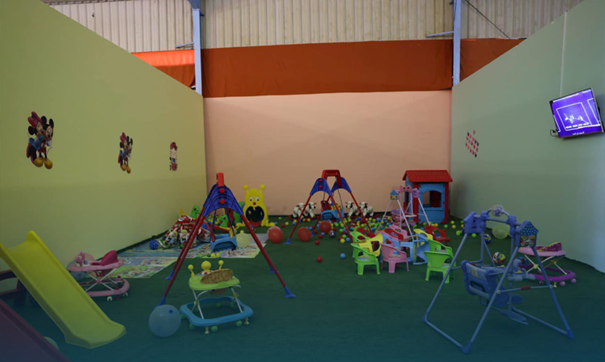 Picture purportedly taken in Abu Salim new DC during its inauguration
Picture purportedly taken in Abu Salim new DC during its inauguration
SSA and DCSIM: competing actors involved in “migration management” in Libya
Over the past year and a half, another actor has emerged in the field of “migration management”. Born in early 2022 from a Fayez al-Sarraj[2] decree, the SSA (Stability Support Apparatus) is a militia conglomerate which was supposed to provide protection services and counteract the previous Interior Minister Fathi Bashagha. Since its creation, many things have changed, and part of the SSA is now close to Bashagha, who was appointed Prime minister in February 2022 by the House of Representatives (based in Tobruk in the east) and opposed to the other Prime minister Abdulhamid al-Dbeibah (supported by the administration based in the West).
This faction of the SSA has created the Department of Combating Settlement and Illegal Migration (DCSIM) which presents itself de facto as a parallel and competing body to the DCIM. Gradually gaining influence and control, the department has at least four patrol boats (three of which are from Turkey) proceeding to interceptions in the Zawiyah area. Since the beginning of 2022, nearly half of the people returned to Libya have been intercepted by the SSA and not by the coastal authorities officially recognized by the GNU and supported by the European Union (so-called Libyan Coast guards and GACS – General Administration for Coastal Security[3]).
The SSA uses its own port, which appears to have been recently excavated on Google maps:
SSA forces are well-known for their brutality. On the 18th of February 2022, the SSA intercepted one boat with 80 people on board and killed one person, while injuring several others.
Al Maya detention center
In addition to its involvement in interceptions at sea, the DCSIM has become a key actor in the detention (and trafficking) system of migrants. Involved in several informal detention facilities, the SSA also manages the Al Maya detention centers, located about 30 km west of Tripoli in a recently repurposed old pharmaceutical factory. According to testimonies collected by Alarmphone, the Al Maya DCs are used to detain and extort migrants intercepted at sea or arrested at checkpoints along the coastal road between Zawiyah and Tripoli. Close cooperation exists between the Zawiyah Coast Guard (controlled by Bija) and the SSA faction controlling the Al Maya port and hangars, migrants being trafficked and transferred from one group to another.
Whereas mass violations against migrants are reported in the Al Maya hangars, the location falls outside of the jurisdiction of the State and is inaccessible to local and international humanitarian organizations. People on the move detained there reported that they witnessed “guards regularly beating detained migrants and refugees and subjecting them to forced labour, rape and other sexual violence, including forced prostitution” .
In January 2022, the Libyan Crimes Watch (LCW) has reported the death of three persons of Moroccan nationality in Al Maya. One of them died under torture while another died after his health deteriorated due to the lack of health care. On the 30th of March, Alarm Phone and other organizations denounced the death of Samy who died on 30 March 2022, as a consequence of being tortured in Al Maya.
The exact number of migrants detained in the Al Mayah area remains unknow, however, some sources report that over 8000 migrants would be detained there. These figures should be treated with caution: no doubt that it is in the interest of the various militias to show that they control more migrants than others, as migration control is an important stake to gain recognition from EU States, especially in the context of the upcoming elections (postponed since December 2021).
An endless cycle of abuse and exploitation in Libya supported by the European Union
Despite the tightening of the EU border regime along the Central Mediterranean, people continue escaping Libya. Whereas many still manage to reach Europe, the proportion of people returned to Libya keeps increasing. In 2021, of over 60.000 people who departed from Libya by sea, half managed to reach Italy while the other half was intercepted. Many people report to Alarm Phone to have been intercepted twice, and sometimes up to 5 or 6 times.
While almost all intercepted persons are sent to more or less official places of detention, the pull-back system (push-back by proxy) orchestrated by the EU is fueling an endless cycle of arbitrary detention, attempted departure and interceptions. The strengthening of smuggling networks and the mass violence to which migrants are subjected in detention are the direct consequences of these shameful policies.
Inside as well as outside of detention centers, Libya is absolutely not a safe country for migrants who daily try to flee the country to find protection. In any case, the EU funding to the UN for assistance and protection cannot be used as a way to justify the system of interceptions and return. And whatever the government’s alleged efforts to give detention centers a more “humane” image, these places remain places of torture and rights violations that Alarm Phone will tirelessly continue to denounce. Interception at sea and detention on land are two sides of the same coin that impede the freedom of movement, perpetuating inequalities, violence and inacceptable regimes of domination and oppression.
 Porta d’Europa. Source: Alarm Phone
Porta d’Europa. Source: Alarm Phone
__
[1] Government of National Unity, provisional government for Libya formed on 10 March 2021 to unify the rival Government of National Accord based in Tripoli (West) and the Second Al-Thani Cabinet based in Tobruk (East)
[2] Previous prime minister of the Government of National Accord from 2016 to 2021
[3] The GACS is under the Ministry of Interior and the so-called Libyan Coast Guard under the Ministry of Defense

